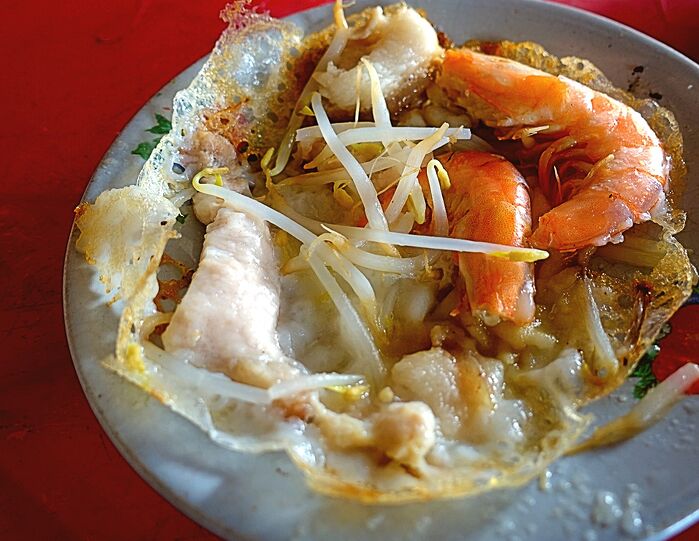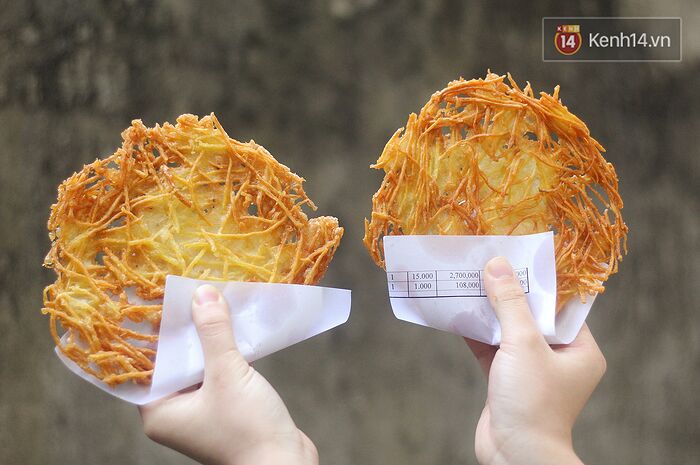Chợ làng Chuồn is a tiny village market on the outskirts of Hue, a mere 20 minutes’ drive from our hotel, Alba, downtown. We’d skipped our hotel’s excellent breakfast buffet in order to save stomach space for our foray into the market to hunt for local eats.
I love the smell of nước mắm in the morning. At Chợ làng Chuồn, it wafted through the air, like the ghost of a rabbit-fish freshly caught off the azure waters of Đầm chuồn Huế a stone’s throw away. We came, Ride of the Valkyries ringing in our heads, tummies a-growling, licking our chops, eyes scanning hungrily for the first bite.
- First stop, xôi lúa or “paddy sticky rice” where the glutinous rice was mixed with corn, and topped with golden-fried shallots, mashed mung beans & white sugar granules. It was utterly delicious and something I simply could not stop eating, even though I’d wanted to pace myself in order to get through our breakfast safari without over-stuffing myself.
Maybe, on a subconscious level, the xôi lúa rekindled childhood taste memories of the Kelantanese pulut pagi, a salty-sweet glutinous rice breakfast dish from Kelantan, the North-east Malaysian state where my maternal side of the family came from, and where the native Kelantanese-Malays descended from ancient Champans, known to the Vietnamese as Lâm Ấp. Ancient foes, but who shared the same tastes, culinary-wise.
- Next, Chợ làng Chuồn’s claim-to-fame, the bánh khoai, a crisp, thick crepe which is a Hue specialty. It’s thicker and smaller than the bánh xèo from the South, but packed a bigger punch flavour-wise. The crepe batter itself consisted mainly of rice flour, which gave the finished product a delightful crunch. Turmeric was usually added to give the crepe a royal, golden-yellow hue.
The bánh khoai was formerly called bánh khỏi or “smoke cake” in the olden days, because when they were served steaming-hot fresh out of the griddle, steam danced gently up into the air like silken threads of smoke. However, Hueans pronounced “khoi” as “khoai”, which sounded like ‘joy’ or ‘happiness’, and the new name stuck, for what could bring greater joy to one than to partake a well-stuffed bánh khoai.
The Huean bánh khoai actually originated from the Southern bánh xèo, but was harder to make as there was a precise ratio of rice flour to eggs that needed to be observed in order to get the texture just right.
Bánh khoai were cooked in heated little iron moulds, to which pork fat was added, followed by whatever ingredients one wishes to have: fish, shrimps, squid, beansprouts or mushrooms. Wait till the meats/vegetables were medium-cooked through, before pouring the batter (mixed into a slurry with water) into the moulds around the half-cooked ingredients. Add a spoonful of beaten egg, and cover.
When the bánh khoai was cooked, with golden-crisp edges, fold them and serve with nước léo, a tangy peanut-tamarind-palm sugar-fish sauce dip. The bánh khoai here at Chợ làng Chuồn eschewed turmeric, and were served flat, allowing its diners to fold or roll up the thick, malleable crepes themselves.
We bought fresh rabbit-fish, shrimps, baby squid and pork-belly from the market stalls nearby and passed them to the bánh khoai vendor to cook. She added beansprouts and scallions to the dish, as she cooked our breakfast for us. The bánh khoai at the market here - there were two competing vendors - were white in colour due to the absence of turmeric.
- Waiting for one’s bánh khoai could take some time, as the two stalls there were terribly busy and the crepes were cooked to order. To assuage our hunger, we also had some bánh ướt, steamed flat rice noodle sheets, akin to Chinese-Cantonese cheung fun. There was one which was simply drizzled with lard and topped with golden-fried lardons, and served with nước chấm. There’s also another one, bánh ướt ngọt, which was filled with sweet mashed mung beans,
- Overall, it was a satisfying brekkie - Vietnamese food always tend to be light, and one doesn’t feel overly sated after a meal. We finished off with another “sweet” treat (“sweet” here can be relative, as Hueans do not have the sweet tooth of, say, Saigonites, so even desserts here don’t really have a high sugar content) - dainty little bánh giò - banana leaf-wrapped glutinous rice flour dumplings with mashed mung bean filling. Shredded coconut strands streaked through the translucent glutinous rice flour pudding, giving the little pyramidical morsel a nice, milky flavour.
Definitely recommend Chợ làng Chuồn for a taste of Vietnamese small village market life. The food were simple and rustic, yet memorable. Do NOT miss the bánh khoai.
Address
Chợ làng Chuồn ( Chuồn village market)
Phú Thị, Phú Vang, Thừa Thiên Huế
Opening hours: 4am to 11pm daily





















